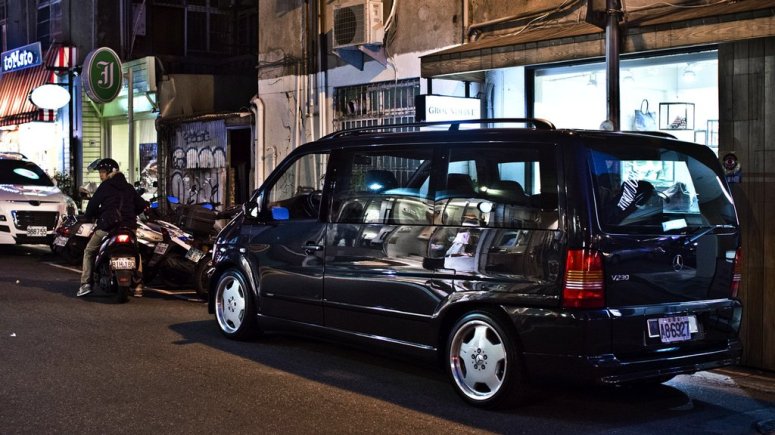MERCEDES BENZ V230 Vito (1997) 
(1996 – 2003)
1:43 Mikro (Schuco)
Part of a popular line of vans, the Viano was introduced at the Geneva Motor Show in 1996 as an outstandingly practical large MPV that marked the end of the rear-wheel drive hegemony over MB products, having been the company’s first vehicle fitted with a front-wheel drive.
Available with a variety of medium-sized engines ranging in displacement from 2.0L to 2.8L, the W638-built van was a formidable get-around family car with plenty of comfort enhancing features such as large sliding lateral doors, a second rear-facing customizable row of seats, meal-tables, cup-holders and a variety of other such accessories. As for the the driver’s instruments, the shift-stick was relocated to the central console right next to the steering wheel for easy access.
From 1999, the V-Class had a new look with new interior equipment and CDI diesel engine. Two CDI models replaced the previous V-Class with turbo-diesel engine. The V 200 CDI had an engine displacement of 2151 cc, an output of 75 kW (102 hp) and developed a torque of 250 Nm between 1,600 and 2,400 rpm. The V 220 CDI had an output of 90 kW (122 hp) and a torque of 300 Nm between 1,800 and 2,500 rpm. This diesel engine had a superior performance, excellent running smoothness and low fuel consumption. The German V 200 CDI and V 220 CDI versions only consumed 8 litres of diesel per 100 km. All other country versions consumed 7.5 litres per 100 km.
 The redesign also included modified 4-cylinder petrol engines for the V 230 and V 200. New were the map-controlled intake camshaft timing, electronic engine management with controller area network (CAN) and sequential petrol injection and anti-knock control that automatically adjusted the ignition point to the quality of the fuel. These measures improved torque development and increased the vehicle’s agility when driving off. The 4-speed automatic transmission was refined and the requirements for the higher torque modified. The new CDI engines were also equipped with a dynamic shift programme (DSP); the electronic transmission control calculated the best shifting point from a number of values, such as the position of the accelerator, inclination, load and towing status.
The redesign also included modified 4-cylinder petrol engines for the V 230 and V 200. New were the map-controlled intake camshaft timing, electronic engine management with controller area network (CAN) and sequential petrol injection and anti-knock control that automatically adjusted the ignition point to the quality of the fuel. These measures improved torque development and increased the vehicle’s agility when driving off. The 4-speed automatic transmission was refined and the requirements for the higher torque modified. The new CDI engines were also equipped with a dynamic shift programme (DSP); the electronic transmission control calculated the best shifting point from a number of values, such as the position of the accelerator, inclination, load and towing status.
The exterior of the V-Class was refreshed with a few targeted changes. The most striking new features were the radiator grille and the side skirts, and the bumpers and door handles that were painted the same colour as the car. The third brake light, which was centre-mounted in the window sill, black anodized metal rails and new paint colours rounded off the changes.
 The major differences between the design and accessory lines TREND, FASHION and AMBIENTE were the interior accessories. The goal was to improve the appeal and quality of the interior as well as its appearance. Key features included a new set of switches and new heating controls in the centre console; a self-testing instrument cluster with redesigned dials; a redesigned steering wheel with airbag cover; modified, chrome inside door handles; new, illuminated switch panel for the power windows and door mirrors; and a seat occupancy and automatic child seat recognition for the front passenger airbag. Additional modifications included new upholstery for the TREND and FASHION lines; carbon trims in the driver and passenger area in the FASHION line and walnut trims in the AMBIENTE line; high-quality panel lining; additional adjustment settings for the driver seat; a new roof control unit with modified interior lighting; and a new multi-function unit in the rear with cup holders and ashtray.
The major differences between the design and accessory lines TREND, FASHION and AMBIENTE were the interior accessories. The goal was to improve the appeal and quality of the interior as well as its appearance. Key features included a new set of switches and new heating controls in the centre console; a self-testing instrument cluster with redesigned dials; a redesigned steering wheel with airbag cover; modified, chrome inside door handles; new, illuminated switch panel for the power windows and door mirrors; and a seat occupancy and automatic child seat recognition for the front passenger airbag. Additional modifications included new upholstery for the TREND and FASHION lines; carbon trims in the driver and passenger area in the FASHION line and walnut trims in the AMBIENTE line; high-quality panel lining; additional adjustment settings for the driver seat; a new roof control unit with modified interior lighting; and a new multi-function unit in the rear with cup holders and ashtray.
The list of optional equipment was expanded and now included a navigation system, Parktronic; tinted glass in the rear side windows; folding door mirrors; and anti-theft warning system with tow-away protection and passenger compartment monitoring. For executives, Mercedes-Benz developed a business console that was easy to set up and remove and contained a docking station for an IBM notebook, a printer, a fixed telephone with fax capability and a reading lamp.
Mercedes-Benz’s V-Class was making a mark in the MPV segment. The production of the W 638 series, which was made in the factory in Vitoria/Spain at the same time as the Vito pick-up truck, ended in the summer of 2003. Approximately 560,000 different vehicles had rolled off the belt. The successor to the V-Class was renamed Viano, while the utility vehicle kept the name Vito.
ENGINE SPECS – V-230 5MT (143 HP) 
Cylinders L4
Displacement 2295 cm3
Power
105 KW @ 5000 RPM / 143 HP @ 5000 RPM / 141 BHP @ 5000 RPM
Torque
155 lb-ft @ 4000 RPM / 210 Nm @ 4000 RPM
Fuel System Multipoint Injection
Fuel Gasoline
PERFORMANCE SPECS
Top Speed 108.1 mph (174 km/h)
Acceleration 0-62 Mph (0-100 kph) 14.5 s
TRANSMISSION SPECS
Drive Type Front Wheel Drive
Gearbox 5-Speed manual
BRAKES – TIRES SPECS
Front Ventilated Discs / Rear Discs
Tire Size 195/70 R15 C 96 T
DIMENSIONS and WEIGHT
Length 183.4 in (4658 mm) / Width 74 in (1880 mm) / Height 72.6 in (1844 mm)
Wheelbase 118.1 in (3000 mm)
Ground Clearance 6.3 in (160 mm)
Cargo Volume 20.5-120.8 cuFT (580 L)
Unladen Weight 4409.2 lbs (2000 kg) / Gross Weight Limit 5798.1 lbs (2630 kg)
FUEL ECONOMY (NEDC)
City 14.2 mpg US (16.6 L/100Km) / Highway 27 mpg US (8.7 L/100Km) / Combined 20.2 mpg US (11.6 L/100Km)
CO2 Emissions 276 g/km



























